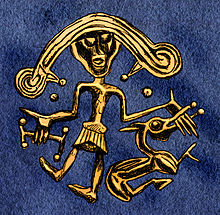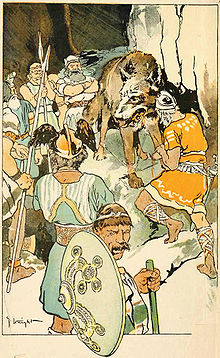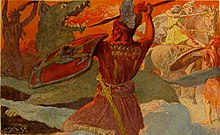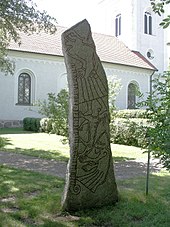Fenrir



Fenrir(Old Norse'fen-dweller')[3]orFenrisúlfr(Old Norse "Fenrir'swolf",often translated" Fenris-wolf "),[4]also referred to asHróðvitnir(Old Norse "fame-wolf" )[5]andVánagandr(Old Norse 'monster of the [River] Ván'),[6]is a monstrous wolf inNorse mythology.In Old Norse texts, Fenrir plays a key role during the events ofRagnarök,where he is foretold to assist in setting the world aflame, resulting in the collapse of humanity and society, and kill the godOdin.
Fenrir, along withHeland theWorld Serpent,is a child ofLokiand female jötunnAngrboða.He is attested in thePoetic Edda,compiled in the 13th century from earlier traditional sources, and theProse EddaandHeimskringla,composed in the 13th century. In both thePoetic EddaandProse Edda,Fenrir is the father of the wolvesSköllandHati Hróðvitnisson,is a son of Loki and is foretold to kill the godOdinduring the events ofRagnarök,but will in turn be killed by Odin's sonVíðarr.
In theProse Edda,additional information is given about Fenrir, including that, due to the gods' knowledge of prophecies foretelling great trouble from Fenrir and his rapid growth, the gods bound him and as a result Fenrir bit off the right hand of the godTýr.Depictions of Fenrir have been identified on various objects and scholarly theories have been proposed regarding Fenrir's relation to other canine beings in Norse mythology. Fenrir has been the subject of artistic depictions and he appears in literature.
Attestations[edit]
Poetic Edda[edit]


Fenrir is mentioned in three stanzas of the poemVöluspáand in two stanzas of the poemVafþrúðnismál.In stanza 40 of the poemVöluspá,avölvadivulges toOdinthat, in the east, an old woman sat in the forestJárnviðr"and bred there the broods of Fenrir. There will come from them all one of that number to be a moon-snatcher introll's skin. "[7]Further into the poem the völva foretells that Odin will be consumed by Fenrir at Ragnarök:
Then is fulfilledHlín's
second sorrow,
when Óðinn goes
to fight with the wolf,
andBeli's slayer,
bright, againstSurtr.
Then shallFrigg's
sweet friend fall.
In the stanza that follows the völva describes that Odin's "tall child of Triumph's Sire" (Odin's son Víðarr) will then come to "strike at the beast of slaughter" and with his hands he will drive a sword into the heart of "Hveðrungr's son ", avenging the death of his father.[8]
In the first of two stanzas mentioning Fenrir inVafþrúðnismálOdin poses a question to the wisejötunnVafþrúðnir:
Much I have travelled, much have I tried out,
much have I tested the Powers;
from where will a sun come into the smooth heaven
when Fenrir has assailed this one?
In the stanza that follows Vafþrúðnir responds that Sól (here referred to asÁlfröðull) will bear a daughter before Fenrir attacks her, and that this daughter shall continue the paths of her deceased mother through the heavens.[9]
Prose Edda[edit]
In theProse Edda,Fenrir is mentioned in three books:Gylfaginning,SkáldskaparmálandHáttatal.
Gylfaginningchapters 13 and 25[edit]
In chapter 13 of theProse EddabookGylfaginning,Fenrir is first mentioned in a stanza quoted fromVöluspá.[10]Fenrir is first mentioned in prose in chapter 25, where the enthroned figure ofHightellsGangleri(described as KingGylfiin disguise) about the godTýr.High says that one example of Týr's bravery is that when theÆsirwere luring Fenrir (referred to here asFenrisúlfr) to place the fetterGleipniron the wolf, Týr placed his hand within the wolf's mouth as a pledge. This was done at Fenrir's own request because he did not trust that the Æsir would let him go. As a result, when the Æsir refused to release him, he bit off Týr's hand at a location "now called the wolf-joint" (thewrist), causing Týr to be one-handed and "not considered to be a promoter of settlements between people."[11]
Gylfaginningchapter 34[edit]


In chapter 34, High describes Loki, and says that Loki had three children with a woman namedAngrboðalocated in the land ofJötunheimr;Fenrisúlfr, the serpentJörmungandr,and the female beingHel.High continues that, once the gods found that these three children were being brought up in the land ofJötunheimr,and when the gods "traced prophecies that from these siblings great mischief and disaster would arise for them" the gods expected a lot of trouble from the three children, partially due to the nature of the mother of the children, yet worse so due to the nature of their father.[12]
High says that Odin sent the gods to gather the children and bring them to him. Upon their arrival, Odin threw Jörmungandr into "that deep sea that lies round all lands", and then threw Hel intoNiflheim,and bestowed upon her authority overnine worlds.However, the Æsir brought up the wolf "at home", and only Týr had the courage to approach Fenrir, and give Fenrir food. The gods noticed that Fenrir was growing rapidly every day, and since all prophecies foretold that Fenrir was destined to cause them harm, the gods formed a plan. The gods preparedthreefetters:The first, greatly strong, was called Leyding. They brought Leyding to Fenrir and suggested that the wolf try his strength with it. Fenrir judged that it was not beyond his strength, and so let the gods do what they wanted with it. At Fenrir's first kick the bind snapped, and Fenrir loosened himself from Leyding. The gods made a second fetter, twice as strong, and named it Dromi. The gods asked Fenrir to try the new fetter, and that should he break this feat of engineering, Fenrir would achieve great fame for his strength. Fenrir considered that, while the fetter was very strong, his strength had grown since he broke Leyding; and also that he would have to take some risks if he were to become famous. Fenrir allowed them to place the fetter.[13]
When the Æsir exclaimed that they were ready, Fenrir shook himself, knocked the fetter to the ground, strained hard, and kicking with his feet, snapped the fetter – breaking it into pieces that flew far into the distance. High says that, as a result, to "loose from Leyding" or to "strike out of Dromi" have become sayings for when something is achieved with great effort. The Æsir started to fear that they would not be able to bind Fenrir, and so Odin sentFreyr's messengerSkírnirdown into the land ofSvartálfaheimrto "somedwarfs"and had them make a fetter called Gleipnir. The dwarves constructed Gleipnir from six mythical ingredients. After an exchange between Gangleri and High, High continues that the fetter was smooth and soft as a silken ribbon, yet strong and firm. The messenger brought the ribbon to the Æsir, and they thanked him heartily for completing the task.[14]
The Æsir went out on to the lakeAmsvartnirsent for Fenrir to accompany them, and continued to the island Lyngvi (Old Norse "a place overgrown withheather").[15]The gods showed Fenrir the silken fetter Gleipnir, told him to tear it, stated that it was much stronger than it appeared, passed it among themselves, used their hands to pull it, and yet it did not tear. However, they said that Fenrir would be able to tear it, to which Fenrir replied:
It looks to me that with this ribbon as though I will gain no fame from it if I do tear apart such a slender band, but if it is made with art and trickery, then even if it does look thin, this band is not going on my legs.[14]
The Æsir said Fenrir would quickly tear apart a thin silken strip, noting that Fenrir earlier broke great iron binds, and added that if Fenrir wasn't able to break slender Gleipnir then Fenrir is nothing for the gods to fear, and as a result would be freed. Fenrir responded:
If you bind me so that I am unable to release myself, then you will be standing by in such a way that I should have to wait a long time before I got any help from you. I am reluctant to have this band put on me. But rather than that you question my courage, let someone put his hand in my mouth as a pledge that this is done in good faith.[16]
With this statement, all of the Æsir look to one another, finding themselves in a dilemma. Everyone refused to place their hand in Fenrir's mouth until Týr put out his right hand and placed it into the wolf's jaws. When Fenrir kicked, Gleipnir caught tightly, and the more Fenrir struggled, the stronger the band grew. At this, everyone laughed, except Týr, who there lost his right hand. When the gods knew that Fenrir was fully bound, they took a cord called Gelgja (Old Norse "fetter" )[17]hanging from Gleipnir, inserted the cord through a large stone slab calledGjöll(Old Norse "scream" ),[18]and the gods fastened the stone slab deep into the ground. After, the gods took a great rock called Thviti (Old Norse "hitter, batterer" ),[19]and thrust it even further into the ground as an anchoring peg. Fenrir reacted violently; he opened his jaws very wide, and tried to bite the gods. Then the gods thrust a sword into his mouth. Its hilt touched the lower jaw and its point the upper one; by means of it the jaws of the wolf were spread apart and the wolf gagged. Fenrir "howled horribly", saliva ran from his mouth, and this saliva formed the river Ván (Old Norse "hope" ).[20]There Fenrir will lie until Ragnarök. Gangleri comments that Loki created a "pretty terrible family" though important, and asks why the Æsir did not just kill Fenrir there since they expected great malice from him. High replies that "so greatly did the gods respect theirholy placesand places of sanctuary that they did not want to defile them with the wolf's blood even though the prophecies say that he will be the death of Odin. "[21]
Gylfaginningchapters 38 and 51[edit]

In chapter 38, High says that there aremany meninValhalla,and many more who will arrive, yet they will "seem too few when the wolf comes".[22]In chapter 51, High foretells that as part of the events of Ragnarök, after Fenrir's sonSköllhas swallowed thesunand his other sonHati Hróðvitnissonhas swallowed themoon,the stars will disappear from the sky. The earth will shake violently, trees will be uprooted, mountains will fall, and all binds will snap – Fenrisúlfr will be free. Fenrisúlfr will go forth with his mouth opened wide, his upper jaw touching the sky and his lower jaw the earth, and flames will burn from his eyes and nostrils.[23]Later, Fenrisúlfr will arrive at the fieldVígríðrwith his sibling Jörmungandr. With the forces assembled there, an immense battle will take place. During this, Odin will ride to fight Fenrisúlfr. During the battle, Fenrisúlfr will eventually swallow Odin, killing him, and Odin's sonVíðarrwill move forward and kick one foot into the lower jaw of the wolf. This foot will bear a legendary shoe "for which the material has been collected throughout all time". With one hand, Víðarr will take hold of the wolf's upper jaw and tear apart his mouth, killing Fenrisúlfr.[24]High follows this prose description by citing various quotes fromVöluspáin support, some of which mention Fenrir.[25]
SkáldskaparmálandHáttatal[edit]
In the Epilogue section of theProse EddabookSkáldskaparmál,aeuhemerizedmonologue equates Fenrisúlfr toPyrrhus,attempting to rationalize that "it killed Odin, and Pyrrhus could be said to be a wolf according to their religion, for he paid no respect to places of sanctuary when he killed the king in the temple in front ofThor's altar. "[26]In chapter 2, "wolf's enemy" is cited as akenningfor Odin as used by the 10th centuryskaldEgill Skallagrímsson.[27]In chapter 9, "feeder of the wolf" is given as a kenning for Týr and, in chapter 11, "slayer of Fenrisúlfr" is presented as a kenning for Víðarr.[28]In chapter 50, a section ofRagnarsdrápaby the 9th century skaldBragi Boddasonis quoted that refers toHel,the being, as "the monstrous wolf's sister".[29]In chapter 75, names forwargsand wolves are listed, including both "Hróðvitnir" and "Fenrir".[30]"Fenrir" appears twice in verse as acommon nounfor a "wolf" or "warg" in chapter 58 ofSkáldskaparmál,and in chapter 56 of the bookHáttatal.[31]Additionally, the name "Fenrir" can be found among a list ofjötnarin chapter 75 ofSkáldskaparmál.[32]
Heimskringla[edit]


At the end of theHeimskringlasagaHákonar saga góða,the poemHákonarmálby the 10th centuryskaldEyvindr skáldaspilliris presented. The poem is about the fall of KingHaakon I of Norway;although he is Christian, he is taken by twovalkyriestoValhalla,and is there received as one of the Einherjar. Towards the end of the poem, a stanza relates sooner will the bonds of Fenrir snap than as good a king as Haakon shall stand in his place:
Unfettered will fare the Fenris Wolf
and ravaged the realm of men,
ere that cometh a kingly prince
as good, to stand in his stead.[33]
Archaeological record[edit]
Thorwald's Cross[edit]

Thorwald's Cross,a partially survivingrunestoneerected at Kirk Andreas on theIsle of Man,depicts a bearded human holding a spear downward at a wolf, his right foot in its mouth, while a large bird sits at his shoulder.[34]Rundatadates it to 940,[35]while Pluskowski dates it to the 11th century.[34]This depiction has been interpreted as Odin, with aravenor eagle at his shoulder, being consumed by Fenrir at Ragnarök.[34][36]On the reverse of the stone is another image parallel to it that has been described as Christ triumphing over Satan.[37]These combined elements have led to the cross as being described as "syncretic art";a mixture ofpaganand Christian beliefs.[34]
Gosforth Cross[edit]
The mid-11th centuryGosforth Cross,located inCumbria,England, has been described as depicting a combination of scenes from the ChristianJudgement Dayand the pagan Ragnarök.[34]The cross features various figures depicted inBorre style,including a man with a spear facing a monstrous head, one of whose feet is thrust into the beast's forked tongue and on its lower jaw, while a hand is placed against its upper jaw, a scene interpreted as Víðarr fighting Fenrir.[34]This depiction has been theorized as a metaphor for Christ's defeat of Satan.[38]
Ledberg stone[edit]

The 11th centuryLedberg stoneinSweden,similarly to Thorwald's Cross, features a figure with his foot at the mouth of a four-legged beast, and this may also be a depiction of Odin being devoured by Fenrir at Ragnarök.[36]Below the beast and the man is a depiction of a legless, helmeted man, with his arms in a prostrate position.[36]TheYounger Futharkinscription on the stone bears a commonly seen memorial dedication, but is followed by an encodedrunicsequence that has been described as "mysterious",[39]and "an interesting magic formula which is known from all over the ancient Norse world".[36]
Other[edit]
If the images on theTullstorp Runestoneare correctly identified as depictingRagnarök,then Fenrir is shown above the shipNaglfar.[40]
Meyer Schapirotheorizes a connection between the "Hell Mouth"that appears in medieval Christian iconography and Fenrir. According to Schapiro," the Anglo-Saxon taste for the Hell Mouth was perhaps influenced by the northern pagan myth of the Crack of Doom and the battle with the wolf, who devoured Odin. "[41]
Scholars propose that a variety of objects from the archaeological record depict Týr. For example, aMigration PeriodgoldbracteatefromTrollhättan,Sweden, features a person receiving a bite on the hand from a beast, which may depict Týr and Fenrir.[42]A Viking AgehogbackinSockburn,County Durham,North East Englandmay depict Týr and Fenrir.[43]
Theories[edit]

In reference to Fenrir's presentation in theProse Edda,Andy Orchard theorizes that "the hound (or wolf)"Garmr,Sköll,andHati Hróðvitnissonwere originally simply all Fenrir, stating that "Snorri, characteristically, is careful to make distinctions, naming the wolves who devour the sun and moon as Sköll and Hati, and describing an encounter between Garm and Týr (who, one would have thought, might like to get his hand on Fenrir) at Ragnarök."[44]
John Lindow says that it is unclear why the gods decide to raise Fenrir as opposed to his siblings Hel and Jörmungandr inGylfaginningchapter 35, theorizing that it may be "because Odin had a connection with wolves? Because Loki was Odin's blood brother?" Referring to the same chapter, Lindow comments that neither of the phrases that Fenrir's binding result in have left any other traces. Lindow compares Fenrir's role to his father Loki and Fenrir's sibling Jörmungandr, in that they all spend time with the gods, are bound or cast out by them, return "at the end of the current mythic order to destroy them, only to be destroyed himself as a younger generation of gods, one of them his slayer, survives into the new world order."[45]He also points to Fenrir's binding as part of a recurring theme of thebound monster,where an enemy of the gods is bound, but destined to break free at Ragnarok.[46]
Indo-Europeanparallels have been proposed between myths of Fenrir and thePersiandemonAhriman.TheYashtsrefer to a story where Taxma Urupi rode Angra Mainyu as a horse for thirty years. An elaboration of this allusion is found only in a late Parsi commentary. The rulerTaxmoruw(Taxma Urupi) managed to lasso Ahriman (Angra Mainyu) and keep him tied up while taking him for a ride three times a day. After thirty years, Ahriman outwitted and swallowed Taxmoruw. In a sexual encounter with Ahriman,Jamshid,Taxmoruw's brother, inserted his hand into Ahriman's anus and pulled out his brother's corpse. His hand withered from contact with the diabolic innards. The suggested parallels with Fenrir myths are the binding of an evil being by a ruler figure and the subsequent swallowing of the ruler figure by the evil being (Odin and Fenrir), trickery involving the thrusting of a hand into a monster's orifice and the affliction of the inserted limb (Týr and Fenrir).[47]
EthologistValerius Geistwrote that Fenrir's maiming and ultimate killing of Odin, who had previously nurtured him, was likely based on true experiences of wolf-behaviour, seeing as wolves are genetically encoded to rise up in the pack hierarchy and have, on occasion, been recorded to rebel against, and kill, their parents. Geist states that "apparently, even the ancients knew that wolves may turn on their parents and siblings and kill them."[48]
Modern influence[edit]
Fenrir appears in modern literature in the poem "Om Fenrisulven og Tyr" (1819) byAdam Gottlob Oehlenschläger(collected inNordens Guder), the novelDer Fenriswolfby K. H. Strobl, andTil kamp mod dødbideriet(1974) by E. K. Reich and E. Larsen.[4]
Fenrir has been depicted in the artworkOdin and Fenris(1909) andThe Binding of Fenris(around 1900) by Dorothy Hardy,Odin und FenriswolfandFesselung des Fenriswolfe(1901) byEmil Doepler,and is the subject of the metal sculptureFenrirbyArne Vinje Gunnerudlocated on the island ofAskøy,Norway.[4]
Fenrir is a highly durable mech option inPixonic's gameWar Robots(released as "Walking War Robots" in 2014).[49]
Fenrir appears as an antagonist in the 2020 videogameAssassin's Creed Valhalla,with a story adapted from the events found inProse Edda.[50]
Fenrir appears in the 2022 gameGod of War Ragnarök.[51]
See also[edit]
Citations[edit]
- ^När Fenrir fick färgArchived30 January 2021 at theWayback Machine,by Magnus Källström, chief runologist atSwedish National Heritage Board.
- ^Analysis supported as convincing in"Bite me" runestonesArchived30 January 2021 at theWayback MachinebyHenrik Williams,professor of North Germanic languages atUppsala University.
- ^Orchard (1997:42).
- ^abcSimek (2007:81).
- ^Simek (2007:160).
- ^Simek (2007:350).
- ^Dronke (1997:17).
- ^Dronke (1997:21–22).
- ^Larrington (1999:47).
- ^Faulkes (1995:15).
- ^Faulkes (1995:25).
- ^Faulkes (1995:26–27).
- ^Faulkes (1995:27).
- ^abFaulkes (1995:28).
- ^Simek (2007:198).
- ^Faulkes (1995:28–29).
- ^Orchard (1997:54).
- ^Orchard (1997:57).
- ^Simek (2007:334).
- ^Simek (2007:350)
- ^Faulkes (1995:29).
- ^Faulkes (1995:32).
- ^Faulkes (1995:53).
- ^Faulkes (1995:54).
- ^Faulkes (1995:55–57).
- ^Faulkes (1995:65–66).
- ^Faulkes (1995:68).
- ^Faulkes (1995:76).
- ^Faulkes (1995:123).
- ^Faulkes (1995:164).
- ^Faulkes (1995:136 and 199).
- ^Faulkes (1995:157).
- ^Hollander (2007:127).
- ^abcdefPluskowski (2004:158).
- ^Entry Br Olsen;185A in Rundata 2.0
- ^abcdJansson (1987:152)
- ^Richards (1999:200).
- ^Schapiro (1942:211, note 66).
- ^MacLeod, Mees (2006:145).
- ^Merrony (2004:136); Crumlin-Pedersen & Thye (1995:170).
- ^Schapiro (1942:211).
- ^See discussion in, for example, Davidson (1993:39–41).
- ^McKinnell (2005:16).
- ^Orchard (1997:43).
- ^Lindow (2001:111–114).
- ^Lindow (2001:82–83).
- ^Puhvel (1988:118–119).
- ^"When do wolves become dangerous to humans?"(PDF).29 September 2007.Archived(PDF)from the original on 25 August 2014.Retrieved5 January2015.
- ^"Fenrir – War Robots".warrobots.com.Archivedfrom the original on 13 March 2022.Retrieved13 March2022.
- ^"Binding Fate – Assassin's Creed Valhalla Wiki Guide".IGN.30 April 2020.Archivedfrom the original on 31 May 2022.Retrieved31 May2022.
- ^LeBlanc, Wesley (6 July 2022)."New God Of War: Ragnarok Trailer Reveals November Release Date".Game Informer.Archivedfrom the original on 6 July 2022.Retrieved6 July2022.
General and cited references[edit]
- Crumlin-Pedersen, Ole & Thye, Birgitte Munch (eds.) (1995).The Ship as Symbol in Prehistoric and Medieval Scandinavia: Papers from an International Research Seminar at the Danish National Museum, Copenhagen, 5–7 May 1994.Nationalmuseet.ISBN87-89384-01-6
- Davidson, Hilda Ellis.1993.The Lost Beliefs of Northern Europe.Routledge.ISBN9780415049368
- Dronke, Ursula (Trans.)(1997).The Poetic Edda: Volume II: Mythological Poems.Oxford University Press.ISBN0-19-811181-9.
- Faulkes, Anthony (Trans.) (1995).Edda.Everyman.ISBN0-460-87616-3
- Hollander, Lee Milton(Trans.) (2007).Heimskringla: History of the Kings of NorwayArchived23 April 2023 at theWayback Machine.University of Texas PressISBN978-0-292-73061-8
- Larrington, Carolyne (Trans.) (1999).The Poetic Edda.Oxford World's Classics.ISBN0-19-283946-2.
- Lindow, John(2001).Norse Mythology: A Guide to Gods, Heroes, Rituals, and Beliefs.Oxford University Press.ISBN0-19-515382-0.
- MacLeod, Mindy; Mees, Bernard (2006).Runic Amulets and Magic Objects.Boydell Press.ISBN1-84383-205-4.Archivedfrom the original on 19 April 2023.Retrieved23 September2016.
- McKinnell, John.2005.Meeting the Other in Norse Myth and Legend.D.S. Brewer.ISBN9781843840428
- Merrony, Mark (2004).The Vikings: Conquerors, Traders and Pirates.Periplus.ISBN1-902699-54-8.
- Orchard, Andy (1997).Dictionary of Norse Myth and Legend.Cassell.ISBN0-304-34520-2.
- Pluskowski, Aleks (2004). "Apocalyptic Monsters: Animal Inspirations for the Iconography of Medieval Northern Devourers". In Bildhauer, Bettina; Mills, Robert (eds.).The Monstrous Middle Ages.University of Toronto Press.pp. 155–176.ISBN0-8020-8667-5.Archivedfrom the original on 2 May 2023.Retrieved23 September2016.
- Puhvel, Jaan (1998).Comparative Mythology.The Johns Hopkins University Press.ISBN0-8018-3413-9.
- Richards, Julian D.(1999). "The Scandinavian Presence". In Hunter, John; Ralston, Ian (eds.).The Archaeology of Britain: An Introduction from the Upper Palaeolithic to the Industrial Revolution.Routledge.pp. 194–209.ISBN0-415-13587-7.Archivedfrom the original on 2 May 2023.Retrieved23 September2016.
- Rundata 2.0 for Windows.
- Schapiro, Meyer(1942). "'Cain's Jaw-Bone that Did the First Murder'".The Art Bulletin.24(3): 205–212.doi:10.2307/3046829.JSTOR3046829.
- Simek, Rudolf(2007).Dictionary of Northern Mythology.translated by Angela Hall.D.S. Brewer.ISBN978-0-85991-513-7.
External links[edit]
- MyNDIR (My Norse Digital Image Repository)Illustrations of Fenrir from manuscripts and early print books.
